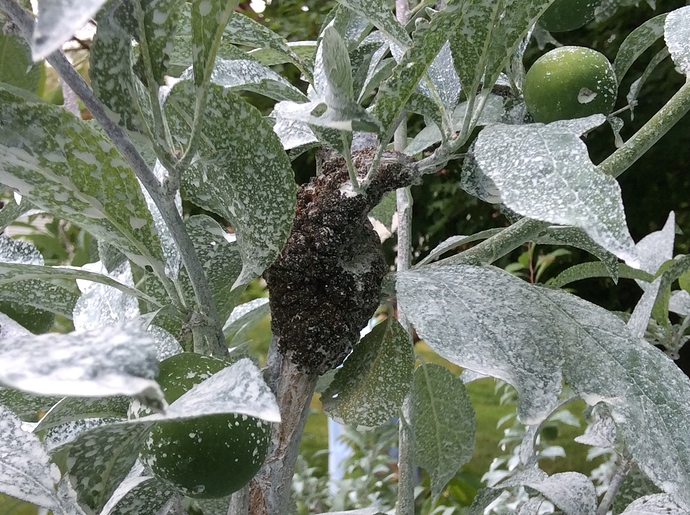I was looking at my Mirabelles yesterday, and sure enough, Black knot got through my showers of spray, so will be pruning and bagging the infested limbs and branches today, then spray again. Oh yuck!`
Got two areas of Black knot on my Shiro, J plum. One of the two areas was right at the base of a branch and pretty much encircled the branch. I could not surgicalky remove it. Off with the whole branch, fruit and all. I am miffed because the location of that branch was so good.
The other spot is on another branch, not as severe. I think I can surgically remove it.
I hate that ugly stuff!
Do you think you could have left it till after the plums were ripe?
You did the best thing. Always remove it immefiately. I have a mitabelle with black knot. Time for more Indar! All of this rain has not helped! Horrible. It’s perfect weather here for black knot this year!
Maybe. I just don’t want that galls to spread more spores.
Although some do not recommend removing BK during growing season.
, I can’t stand the sight of it. The other one dod not look as bad, I eillremove it when the tree goes dormant.
Chlorothalonil is supposed to be fungicide that could treat it. I don’t want to own another fungicide so I will continue tp spray copper at dormant.
It will spread!
The Indar label says it treats it
Thanks Lois, actually its the only fungicide that has worked for black knot in my book. Monterey FF was good for While, but in the fall it would return. I trust
Indar. Why not go with something that works?
I was thinking about using Indar, too, since I have it. I’ve sprayed it twice already this year. I am not sure if I’d like to spray it again.
I sprayed the copper and Indar in the spring, haven’t seen anymore since
Of course that doesn’t mean it’s not there
I’ve been spraying Indar and I still have knots as usual. I also sprayed a delayed dormant copper.
According to the midwest spray guide only Bravo rates excellent for knot control. Copper gets a poor and Indar is not rated.
I think I see more black knot after 4-5 years of growing the trees (similar to brown rot). Last year was the first time I saw BK on my Euro and a bit on Shiro. I surgically removed it. This year, there has been more of it even though our weather is not wetter than normal.
[quote=“scottfsmith, post:91, topic:1223”]
According to the midwest spray guide only Bravo rates excellent for knot control.
Of course, not many plums are grown in the midwest. Guidelines I’ve read from Cornell and others rate no fungicide as adequately effective and cutting out galls by hand is always included as a requirement for containment. I’ve tried Brav and wasn’t impressed enough to continue using it, but I was not at all scientific in my manner of evaluation. It’s been so bad at many sites last few years I may have to start putting some in my tank for early spring sprays to see if it helps. You would have to use it for a couple seasons to really get any idea on what is being accomplished. I’m not sure how long the incubation period is on this disease, but I cut out all black knot in my nursery a month ago and we’ve been dry since but new galls are showing up.
I was told by a commercial grower that one Cornell guru at a conference said to think of plums as short lived trees- make your money for a few years than when the BK overwhelms the trees replace them. If chlorthalinal was very effective this advice wouldn’t make much sense.
If I don’t cut the stuff off during the entire growing season I can’t control it- I’m certain of that. It’s fine to just do it when trees are dormant if pressure is relatively light, but in bad cases it keeps spreading during the growing season at a much higher rate if you don’t stay on top of the galls- that is my repeated experience, anyway. The only time I leave galls for a crop is if I plan to eliminate the trees after it bears the crop.
Chlorithalonil recommendation is from Penn State.
Well, I am using Indar for brown rot. I may as well spray it forvthe fun if it.
What I wonder with fungicides is - is it better to alternate modes of action, or to dump them all together into the same sprayer?
Cornell is the big cheese with most guidelines in our region- at least in New England, and likely originated the recommendation, but I doubt Penn St. claimed Chlor produces excellent control because I feel certain it does not and have often read it doesn’t. I don’t think Scot believes it does either, but he hasn’t responded.
Here’s a nice sheet I just searched up that actually will change my approach to managing the disease a bit.
It’s good to know about the specific timing
And no mention of copper
And yet the article you quote says Chlorinhalonil is the best fungicide to use. Do you use it or something else?
I looked at my logs and two years ago when I had bad knot I sprayed chlorothalonil once on my plums and I still had a lot of new knots showing up later.
I keep on finding more knots this year, its a bit worse than usual. I might try some new treatments for experiments.
There is quite a chasm between providing excellent control and being the most effective available fungicide. My point is only that I believe the most important thing is to cut out the galls. It’s probably also a good idea to include chlor in early sprays where BK is a big problem.


